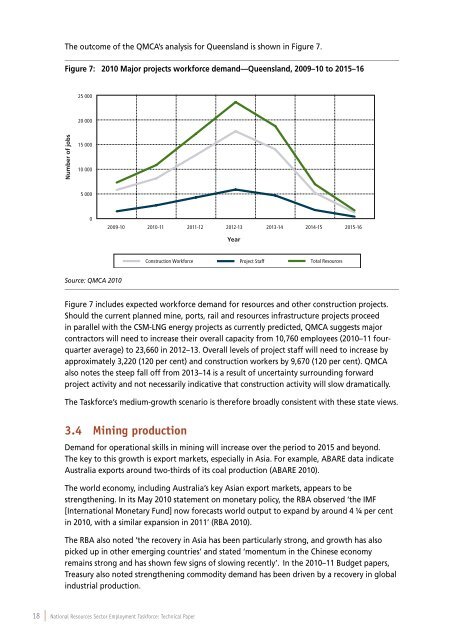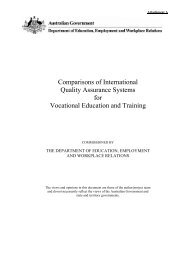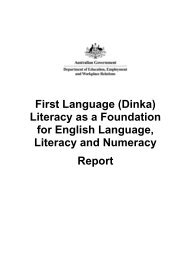National Resources Sector Employment Taskforce Technical Paper
National Resources Sector Employment Taskforce Technical Paper
National Resources Sector Employment Taskforce Technical Paper
Create successful ePaper yourself
Turn your PDF publications into a flip-book with our unique Google optimized e-Paper software.
The outcome of the QMCA’s analysis for Queensland is shown in Figure 7.<br />
Figure 7: 2010 Major projects workforce demand—Queensland, 2009–10 to 2015–16<br />
25 000<br />
20 000<br />
Number of jobs<br />
15 000<br />
10 000<br />
5 000<br />
0<br />
2009-10 2010-11 2011-12 2012-13 2013-14 2014-15 2015-16<br />
Year<br />
Construction Workforce Project Staff Total <strong>Resources</strong><br />
Source: QMCA 2010<br />
Figure 7 includes expected workforce demand for resources and other construction projects.<br />
Should the current planned mine, ports, rail and resources infrastructure projects proceed<br />
in parallel with the CSM-LNG energy projects as currently predicted, QMCA suggests major<br />
contractors will need to increase their overall capacity from 10,760 employees (2010–11 fourquarter<br />
average) to 23,660 in 2012–13. Overall levels of project staff will need to increase by<br />
approximately 3,220 (120 per cent) and construction workers by 9,670 (120 per cent). QMCA<br />
also notes the steep fall off from 2013–14 is a result of uncertainty surrounding forward<br />
project activity and not necessarily indicative that construction activity will slow dramatically.<br />
The <strong>Taskforce</strong>’s medium-growth scenario is therefore broadly consistent with these state views.<br />
3.4 Mining production<br />
Demand for operational skills in mining will increase over the period to 2015 and beyond.<br />
The key to this growth is export markets, especially in Asia. For example, ABARE data indicate<br />
Australia exports around two-thirds of its coal production (ABARE 2010).<br />
The world economy, including Australia’s key Asian export markets, appears to be<br />
strengthening. In its May 2010 statement on monetary policy, the RBA observed ‘the IMF<br />
[International Monetary Fund] now forecasts world output to expand by around 4 ¼ per cent<br />
in 2010, with a similar expansion in 2011’ (RBA 2010).<br />
The RBA also noted ‘the recovery in Asia has been particularly strong, and growth has also<br />
picked up in other emerging countries’ and stated ‘momentum in the Chinese economy<br />
remains strong and has shown few signs of slowing recently’. In the 2010–11 Budget papers,<br />
Treasury also noted strengthening commodity demand has been driven by a recovery in global<br />
industrial production.<br />
18 | <strong>National</strong> <strong>Resources</strong> <strong>Sector</strong> <strong>Employment</strong> <strong>Taskforce</strong>: <strong>Technical</strong> <strong>Paper</strong>
















